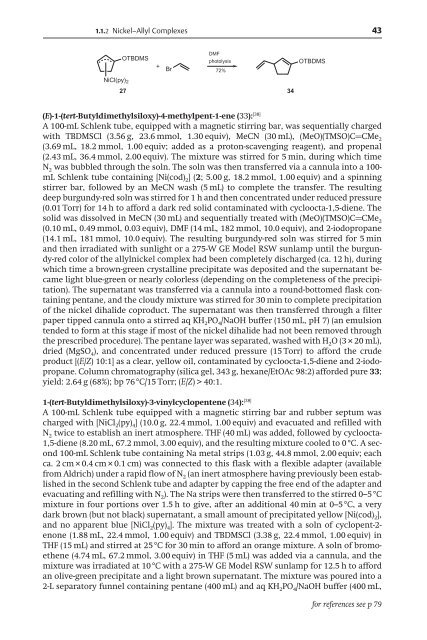You also want an ePaper? Increase the reach of your titles
YUMPU automatically turns print PDFs into web optimized ePapers that Google loves.
1.1.2 Nickel–Allyl Complexes 43<br />
NiCl(py)2<br />
27<br />
OTBDMS<br />
+<br />
Br<br />
DMF<br />
photolysis<br />
72%<br />
34<br />
OTBDMS<br />
(E)-1-(tert-Butyldimethylsiloxy)-4-methylpent-1-ene (33): [38]<br />
A 100-mL Schlenk tube, equipped with a magnetic stirring bar, was sequentially charged<br />
with TBDMSCl (3.56 g, 23.6 mmol, 1.30 equiv), MeCN (30 mL), (MeO)(TMSO)C=CMe 2<br />
(3.69 mL, 18.2 mmol, 1.00 equiv; added as a proton-scavenging reagent), and propenal<br />
(2.43 mL, 36.4 mmol, 2.00 equiv). The mixture was stirred for 5 min, during which time<br />
N 2 was bubbled through the soln. The soln was then transferred via a cannula into a 100mL<br />
Schlenk tube containing [Ni(cod) 2](2; 5.00 g, 18.2 mmol, 1.00 equiv) and a spinning<br />
stirrer bar, followed by an MeCN wash (5 mL) to complete the transfer. The resulting<br />
deep burgundy-red soln was stirred for 1 h and then concentrated under reduced pressure<br />
(0.01 Torr) for 14 h to afford a dark red solid contaminated with cycloocta-1,5-diene. The<br />
solid was dissolved in MeCN (30 mL) and sequentially treated with (MeO)(TMSO)C=CMe 2<br />
(0.10 mL, 0.49 mmol, 0.03 equiv), DMF (14 mL, 182 mmol, 10.0 equiv), and 2-iodopropane<br />
(14.1 mL, 181 mmol, 10.0 equiv). The resulting burgundy-red soln was stirred for 5 min<br />
and then irradiated with sunlight or a 275-W GE Model RSW sunlamp until the burgundy-red<br />
color of the allylnickel complex had been completely discharged (ca. 12 h), during<br />
which time a brown-green crystalline precipitate was deposited and the supernatant became<br />
light blue-green or nearly colorless (depending on the completeness of the precipitation).<br />
The supernatant was transferred via a cannula into a round-bottomed flask containing<br />
pentane, and the cloudy mixture was stirred for 30 min to complete precipitation<br />
of the nickel dihalide coproduct. The supernatant was then transferred through a filter<br />
paper tipped cannula onto a stirred aq KH 2PO 4/NaOH buffer (150 mL, pH 7) (an emulsion<br />
tended to form at this stage if most of the nickel dihalide had not been removed through<br />
the prescribed procedure). The pentane layer was separated, washed with H 2O(3”20mL),<br />
dried (MgSO 4), and concentrated under reduced pressure (15 Torr) to afford the crude<br />
product [(E/Z) 10:1] as a clear, yellow oil, contaminated by cycloocta-1,5-diene and 2-iodopropane.<br />
Column chromatography (silica gel, 343 g, hexane/EtOAc 98:2) afforded pure 33;<br />
yield: 2.64 g (68%); bp 768C/15 Torr; (E/Z) > 40:1.<br />
1-(tert-Butyldimethylsiloxy)-3-vinylcyclopentene (34): [38]<br />
A 100-mL Schlenk tube equipped with a magnetic stirring bar and rubber septum was<br />
charged with [NiCl 2(py) 4] (10.0 g, 22.4 mmol, 1.00 equiv) and evacuated and refilled with<br />
N 2 twice to establish an inert atmosphere. THF (40 mL) was added, followed by cycloocta-<br />
1,5-diene (8.20 mL, 67.2 mmol, 3.00 equiv), and the resulting mixture cooled to 0 8C. A second<br />
100-mL Schlenk tube containing Na metal strips (1.03 g, 44.8mmol, 2.00 equiv; each<br />
ca. 2 cm ” 0.4 cm ” 0.1 cm) was connected to this flask with a flexible adapter (available<br />
from Aldrich) under a rapid flow of N 2 (an inert atmosphere having previously been established<br />
in the second Schlenk tube and adapter by capping the free end of the adapter and<br />
evacuating and refilling with N 2). The Na strips were then transferred to the stirred 0–58C<br />
mixture in four portions over 1.5 h to give, after an additional 40 min at 0–58C, a very<br />
dark brown (but not black) supernatant, a small amount of precipitated yellow [Ni(cod) 2],<br />
and no apparent blue [NiCl 2(py) 4]. The mixture was treated with a soln of cyclopent-2enone<br />
(1.88mL, 22.4 mmol, 1.00 equiv) and TBDMSCl (3.38g, 22.4 mmol, 1.00 equiv) in<br />
THF (15 mL) and stirred at 258C for 30 min to afford an orange mixture. A soln of bromoethene<br />
(4.74 mL, 67.2 mmol, 3.00 equiv) in THF (5 mL) was added via a cannula, and the<br />
mixture was irradiated at 10 8C with a 275-W GE Model RSW sunlamp for 12.5 h to afford<br />
an olive-green precipitate and a light brown supernatant. The mixture was poured into a<br />
2-L separatory funnel containing pentane (400 mL) and aq KH 2PO 4/NaOH buffer (400 mL,<br />
for references see p 79
















